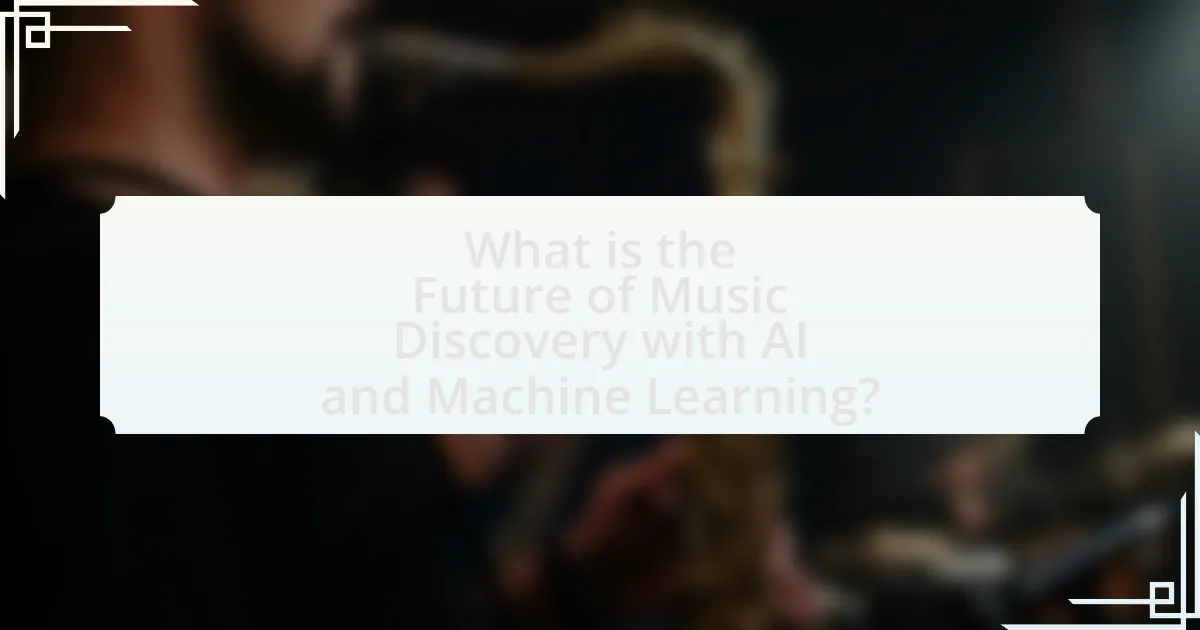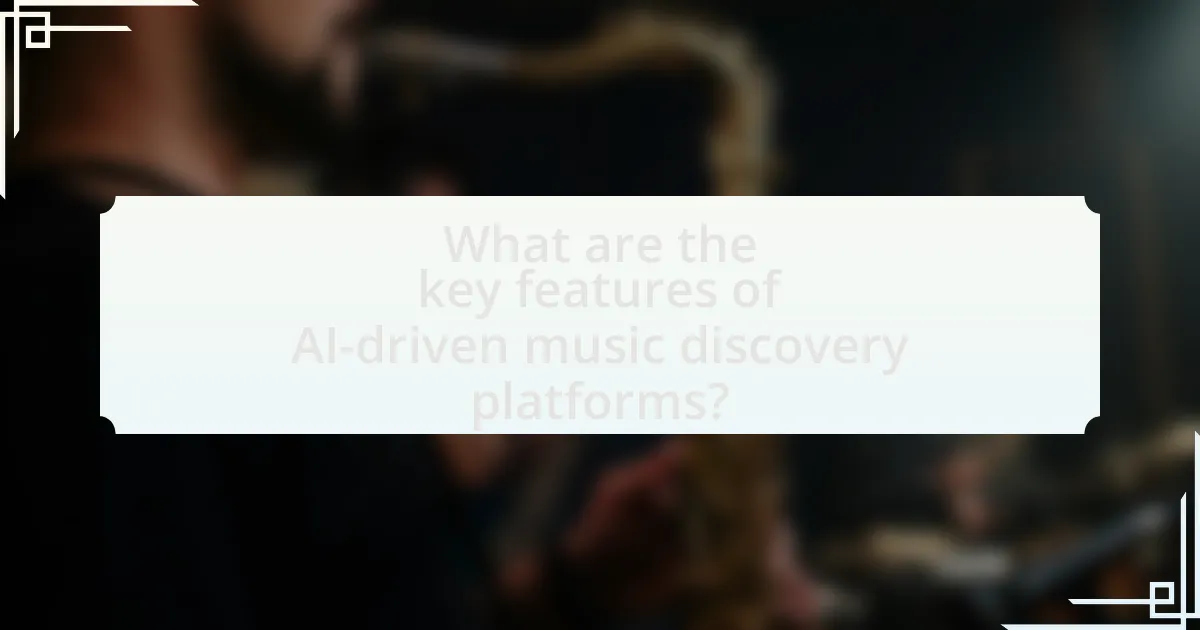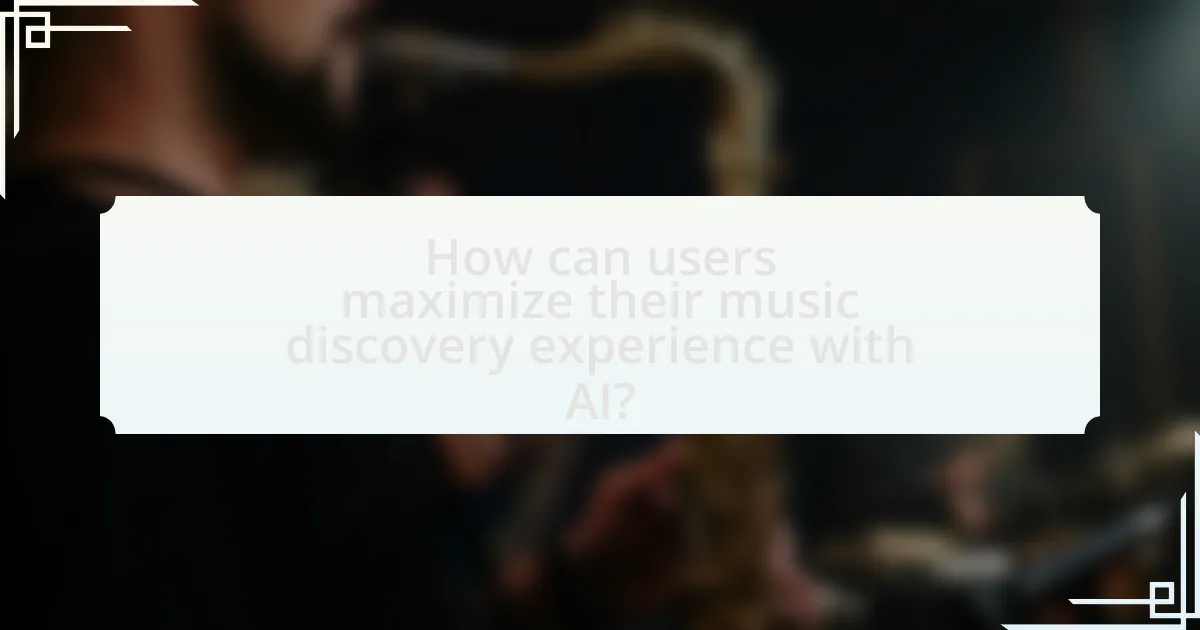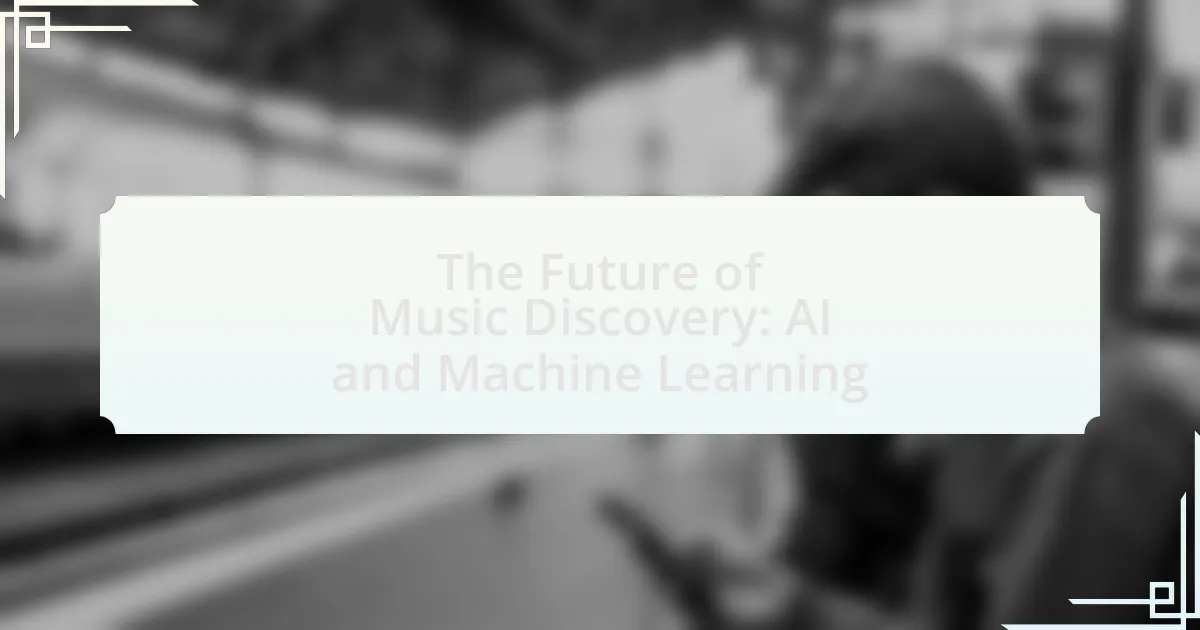The article focuses on the future of music discovery through the lens of artificial intelligence (AI) and machine learning. It highlights how these technologies enhance personalized music recommendations by analyzing user preferences, listening habits, and contextual data, leading to improved user engagement. Key topics include the transformation of music discovery via advanced algorithms, the role of user data in refining recommendations, and the challenges listeners face, such as algorithmic bias and information overload. Additionally, the article discusses the impact of effective music discovery on artists and the industry, as well as emerging trends and best practices for users to maximize their music discovery experience.

What is the Future of Music Discovery with AI and Machine Learning?
The future of music discovery with AI and machine learning is characterized by personalized recommendations and enhanced user experiences. AI algorithms analyze user preferences, listening habits, and contextual data to curate tailored playlists and suggest new artists, significantly improving the relevance of music recommendations. For instance, platforms like Spotify and Apple Music utilize machine learning models that process vast amounts of data, enabling them to predict user tastes with high accuracy. Research indicates that personalized music recommendations can increase user engagement by up to 30%, demonstrating the effectiveness of AI in transforming music discovery.
How are AI and Machine Learning transforming music discovery?
AI and Machine Learning are transforming music discovery by enabling personalized recommendations and enhancing user engagement. Algorithms analyze user listening habits, preferences, and behaviors to curate tailored playlists and suggest new artists, significantly improving the relevance of music suggestions. For instance, platforms like Spotify utilize collaborative filtering and natural language processing to understand user tastes, resulting in over 40% of users discovering new music through personalized playlists. This data-driven approach not only increases user satisfaction but also helps emerging artists reach their target audience more effectively.
What technologies are driving AI and Machine Learning in music?
Artificial Intelligence and Machine Learning in music are primarily driven by technologies such as neural networks, natural language processing, and deep learning algorithms. Neural networks, particularly convolutional neural networks (CNNs), are utilized for audio analysis and music generation, enabling systems to learn patterns and features from large datasets of music. Natural language processing facilitates the understanding of lyrics and user preferences, enhancing recommendation systems. Deep learning algorithms improve the accuracy of music classification and generation, as evidenced by platforms like Spotify and Apple Music, which leverage these technologies to personalize user experiences and curate playlists based on listening habits.
How do algorithms personalize music recommendations?
Algorithms personalize music recommendations by analyzing user data, including listening history, preferences, and behavior patterns. These algorithms utilize techniques such as collaborative filtering, which identifies similarities between users and suggests music based on what similar users have enjoyed. Additionally, content-based filtering examines the characteristics of songs, such as genre, tempo, and instrumentation, to recommend tracks that align with a user’s tastes. Research indicates that platforms like Spotify and Pandora employ these methods, resulting in increased user engagement and satisfaction, as evidenced by Spotify’s claim that personalized playlists drive over 30% of their total streams.
Why is music discovery important in today’s digital landscape?
Music discovery is crucial in today’s digital landscape because it enables listeners to find new artists and genres amidst an overwhelming volume of content. With over 60,000 new tracks uploaded daily on platforms like Spotify, effective music discovery tools, powered by AI and machine learning, help users navigate this vast array of options. These technologies analyze user preferences and listening habits, providing personalized recommendations that enhance user engagement and satisfaction. According to a 2021 report by the International Federation of the Phonographic Industry, 70% of users rely on algorithmic recommendations to discover new music, highlighting the importance of these systems in shaping listening experiences.
What challenges do listeners face in discovering new music?
Listeners face several challenges in discovering new music, primarily due to information overload and algorithmic bias. The vast amount of available music, with over 60,000 tracks uploaded daily on platforms like Spotify, can overwhelm listeners, making it difficult to sift through and find new favorites. Additionally, algorithms often prioritize popular or mainstream music, which can limit exposure to diverse genres and emerging artists. Research from the International Journal of Information Management highlights that users frequently rely on familiar artists, leading to a phenomenon known as the “filter bubble,” where they miss out on innovative sounds and styles. These challenges hinder listeners’ ability to explore and enjoy the full spectrum of music available today.
How does effective music discovery impact artists and the industry?
Effective music discovery significantly enhances artists’ visibility and revenue potential while transforming the music industry landscape. When listeners can easily find new music through algorithms and personalized recommendations, artists gain access to wider audiences, leading to increased streaming numbers and concert attendance. For instance, a study by Nielsen Music found that 70% of listeners discover new music through streaming services, which directly correlates with higher engagement for artists. This shift not only benefits individual musicians but also drives industry growth, as record labels and platforms adapt to prioritize data-driven strategies that cater to consumer preferences.

What are the key features of AI-driven music discovery platforms?
AI-driven music discovery platforms primarily feature personalized recommendations, advanced algorithms for analyzing user preferences, and enhanced content curation. These platforms utilize machine learning to analyze listening habits, enabling them to suggest songs and artists that align with individual tastes. For instance, Spotify’s algorithm considers factors such as song tempo, genre, and user interactions to create tailored playlists. Additionally, these platforms often incorporate collaborative filtering, which identifies similarities between users to enhance discovery. The effectiveness of these features is supported by data showing that personalized recommendations can increase user engagement by up to 30%, demonstrating their impact on music discovery.
How do streaming services utilize AI for music recommendations?
Streaming services utilize AI for music recommendations by analyzing user data and preferences to create personalized playlists and suggestions. These platforms employ machine learning algorithms that process vast amounts of listening history, song attributes, and user interactions to identify patterns and predict what users are likely to enjoy. For instance, Spotify’s recommendation system uses collaborative filtering and natural language processing to analyze user behavior and content descriptions, resulting in tailored music suggestions that enhance user engagement. This approach has been shown to significantly improve user satisfaction and retention, as evidenced by Spotify’s reported increase in user engagement metrics following the implementation of AI-driven recommendations.
What role does user data play in enhancing recommendations?
User data plays a crucial role in enhancing recommendations by providing insights into individual preferences and behaviors. This data allows algorithms to analyze patterns, such as listening habits and song ratings, which can be used to tailor suggestions that align with a user’s unique tastes. For instance, platforms like Spotify utilize user data to create personalized playlists, leveraging machine learning techniques that analyze millions of user interactions to improve accuracy in recommendations. Studies have shown that personalized recommendations can increase user engagement by up to 30%, demonstrating the effectiveness of utilizing user data in refining recommendation systems.
How do collaborative filtering and content-based filtering differ?
Collaborative filtering and content-based filtering differ primarily in their approach to recommendation systems. Collaborative filtering relies on user interactions and preferences, analyzing patterns from multiple users to suggest items based on the collective behavior of similar users. In contrast, content-based filtering focuses on the attributes of the items themselves, recommending items similar to those a user has liked in the past based on specific features such as genre, artist, or tempo. This distinction is supported by the fact that collaborative filtering can uncover hidden preferences through social connections, while content-based filtering is limited to the user’s historical data and item characteristics.
What innovations are emerging in music discovery through AI?
Innovations in music discovery through AI include personalized recommendation systems, automated playlist generation, and enhanced search capabilities. Personalized recommendation systems utilize machine learning algorithms to analyze user listening habits and preferences, resulting in tailored music suggestions that improve user engagement. Automated playlist generation employs AI to curate playlists based on mood, genre, or activity, streamlining the listening experience. Enhanced search capabilities leverage natural language processing to allow users to find music using conversational queries, making the discovery process more intuitive. These advancements are supported by data from platforms like Spotify and Apple Music, which report increased user satisfaction and engagement due to AI-driven features.
How are natural language processing and sentiment analysis applied?
Natural language processing (NLP) and sentiment analysis are applied in music discovery by analyzing user-generated content, such as reviews and social media posts, to gauge listener preferences and emotional responses to music. This application enables music platforms to recommend songs and artists that align with users’ tastes, enhancing personalized experiences. For instance, Spotify utilizes NLP to analyze lyrics and user comments, allowing it to curate playlists that resonate with specific moods or sentiments, thereby improving user engagement and satisfaction.
What future trends can we expect in AI music discovery?
Future trends in AI music discovery include enhanced personalization through advanced algorithms, improved contextual understanding of user preferences, and the integration of multi-modal data sources. These trends are driven by the increasing capabilities of machine learning models to analyze vast amounts of data, including listening habits, social media interactions, and even emotional responses to music. For instance, Spotify’s recommendation system utilizes collaborative filtering and natural language processing to tailor playlists, demonstrating the effectiveness of AI in creating personalized music experiences. Additionally, the rise of generative AI tools allows for the creation of unique music tracks based on user input, further expanding the landscape of music discovery.

How can users maximize their music discovery experience with AI?
Users can maximize their music discovery experience with AI by utilizing personalized recommendation systems that analyze listening habits and preferences. These systems, such as those employed by platforms like Spotify and Apple Music, leverage machine learning algorithms to curate playlists and suggest new artists based on user behavior, enhancing the likelihood of discovering music that aligns with individual tastes. Research indicates that personalized recommendations can increase user engagement by up to 30%, demonstrating the effectiveness of AI in tailoring music experiences.
What strategies can listeners employ to discover new music effectively?
Listeners can effectively discover new music by utilizing personalized streaming algorithms, exploring curated playlists, and engaging with music discovery platforms. Personalized streaming algorithms, such as those used by Spotify and Apple Music, analyze user listening habits to recommend songs and artists that align with individual tastes. Curated playlists, often created by music experts or algorithms, provide a selection of tracks that introduce listeners to new genres and artists. Additionally, music discovery platforms like Bandcamp and SoundCloud allow users to explore independent artists and niche genres, expanding their musical horizons. These strategies leverage technology and community insights to enhance the music discovery experience.
How can users leverage playlists and curated content for better discovery?
Users can leverage playlists and curated content to enhance music discovery by utilizing algorithm-driven recommendations that tailor selections to individual listening habits. These playlists often aggregate tracks based on user preferences, listening history, and trending songs, making it easier for users to find new music that aligns with their tastes. For instance, platforms like Spotify and Apple Music employ machine learning algorithms that analyze user data to create personalized playlists, such as Discover Weekly, which has been shown to increase user engagement and satisfaction by introducing listeners to artists and genres they may not have encountered otherwise.
What role do social media and community engagement play in music discovery?
Social media and community engagement are crucial in music discovery as they facilitate direct interaction between artists and listeners, enabling the sharing and promotion of new music. Platforms like Instagram, TikTok, and Twitter allow users to discover emerging artists through viral trends, user-generated content, and recommendations from peers. For instance, a study by Nielsen Music found that 56% of music fans discover new music through social media, highlighting its significant impact. Additionally, community engagement fosters a sense of belonging and loyalty among fans, which can lead to increased support for artists and their work. This dynamic interaction not only enhances visibility for new music but also shapes listener preferences and trends in the industry.
What are the potential drawbacks of AI in music discovery?
The potential drawbacks of AI in music discovery include algorithmic bias, lack of diversity in recommendations, and over-reliance on data-driven insights. Algorithmic bias can lead to the reinforcement of existing preferences, limiting exposure to new genres or artists. For instance, a study by the University of California, Berkeley, found that recommendation systems often favor popular tracks, which can marginalize lesser-known musicians. Additionally, the lack of diversity in recommendations can create echo chambers, where users are only exposed to music similar to what they already like, stifling musical exploration. Over-reliance on data-driven insights may also result in a diminished human touch in music curation, as AI systems prioritize metrics over emotional resonance.
How can algorithmic bias affect music recommendations?
Algorithmic bias can significantly affect music recommendations by skewing the diversity of suggested tracks based on the data used to train recommendation systems. When algorithms are trained on historical data that reflects existing biases—such as favoring popular genres or artists—these biases can perpetuate a narrow range of music being recommended to users. For instance, a study by the University of California, Berkeley, found that recommendation systems often prioritize mainstream music, leading to a lack of exposure for independent or less popular artists. This can result in users receiving a limited selection of music that does not represent the full spectrum of available options, ultimately shaping their listening habits and preferences in a biased manner.
What privacy concerns arise from data collection in music discovery?
Data collection in music discovery raises significant privacy concerns, primarily related to user data tracking and profiling. Music streaming services often collect extensive data on user listening habits, preferences, and personal information, which can lead to unauthorized sharing or selling of this data to third parties. For instance, a study by the Electronic Frontier Foundation highlights that many music apps track users’ locations and interactions without explicit consent, increasing the risk of data breaches and misuse. Additionally, the aggregation of personal data can result in invasive profiling, where users are categorized based on their listening behavior, potentially leading to targeted advertising that infringes on individual privacy rights.
What best practices should users follow for effective music discovery?
To achieve effective music discovery, users should actively engage with music streaming platforms that utilize AI and machine learning algorithms. These platforms analyze listening habits and preferences to recommend personalized playlists and new artists. For instance, Spotify’s Discover Weekly feature curates a list of songs tailored to individual tastes based on previous listening behavior, demonstrating the effectiveness of AI in enhancing music discovery. Additionally, users should explore curated playlists and follow music blogs or social media accounts that focus on emerging artists, as these resources often highlight new trends and hidden gems in the music industry.

Leave a Reply